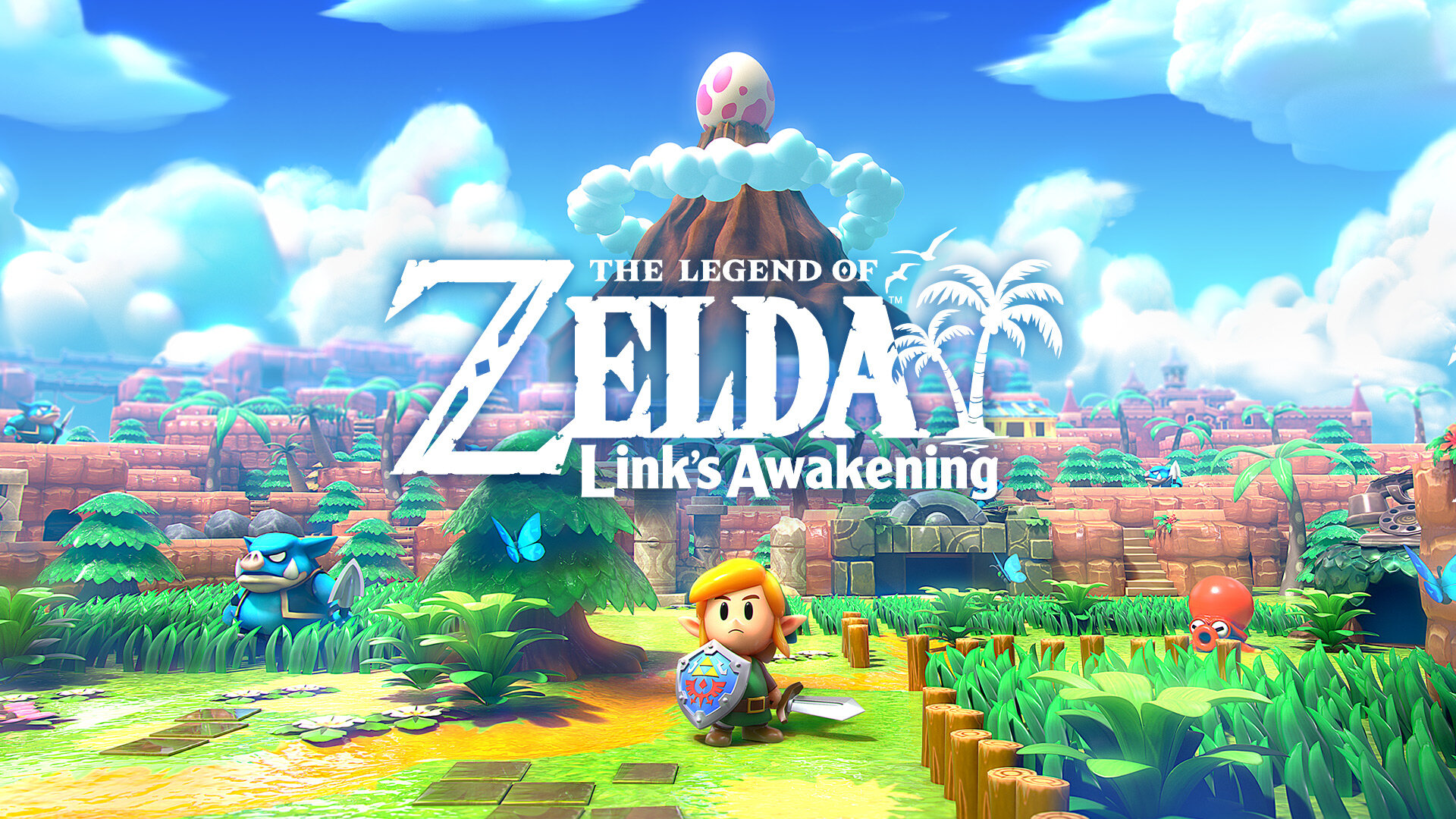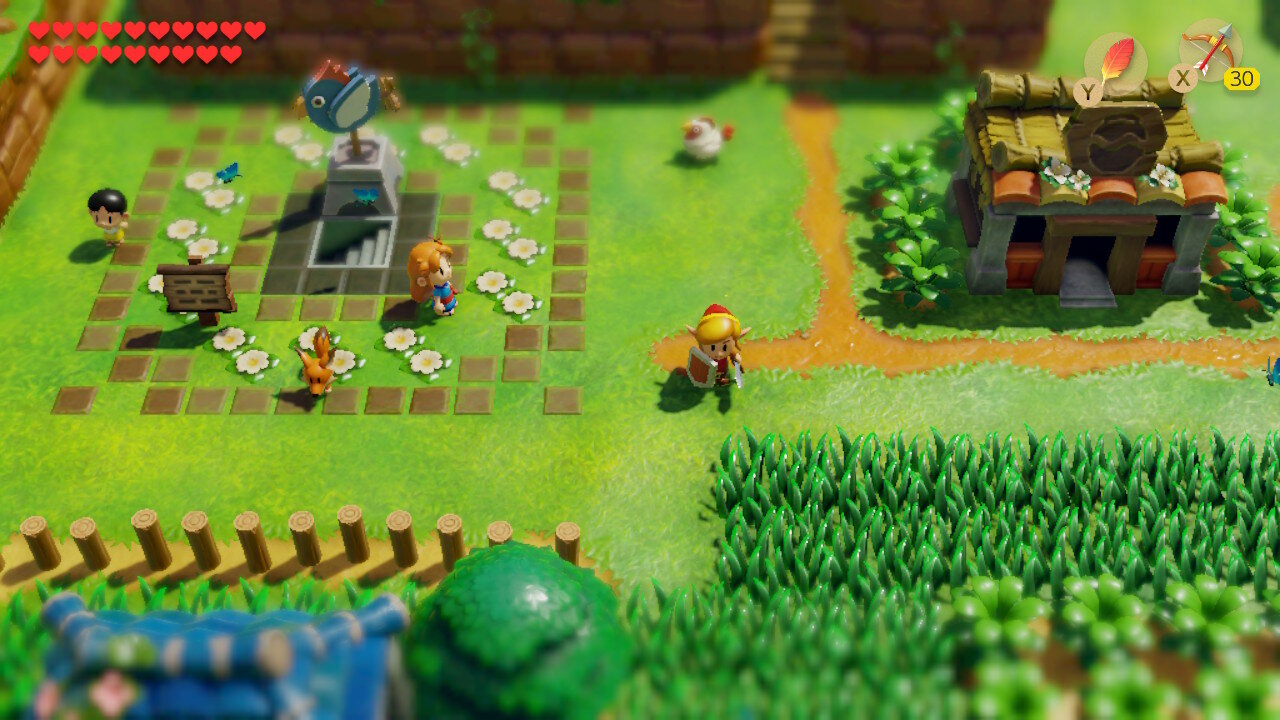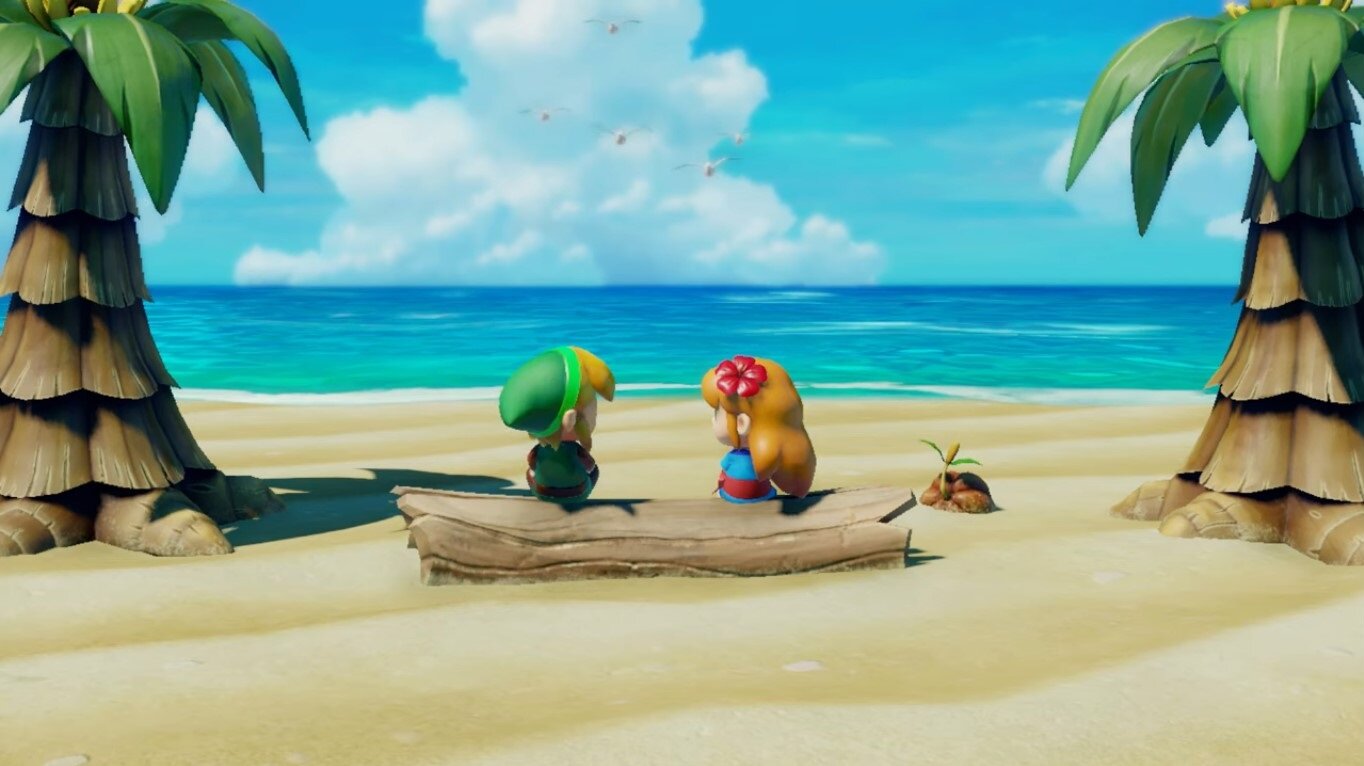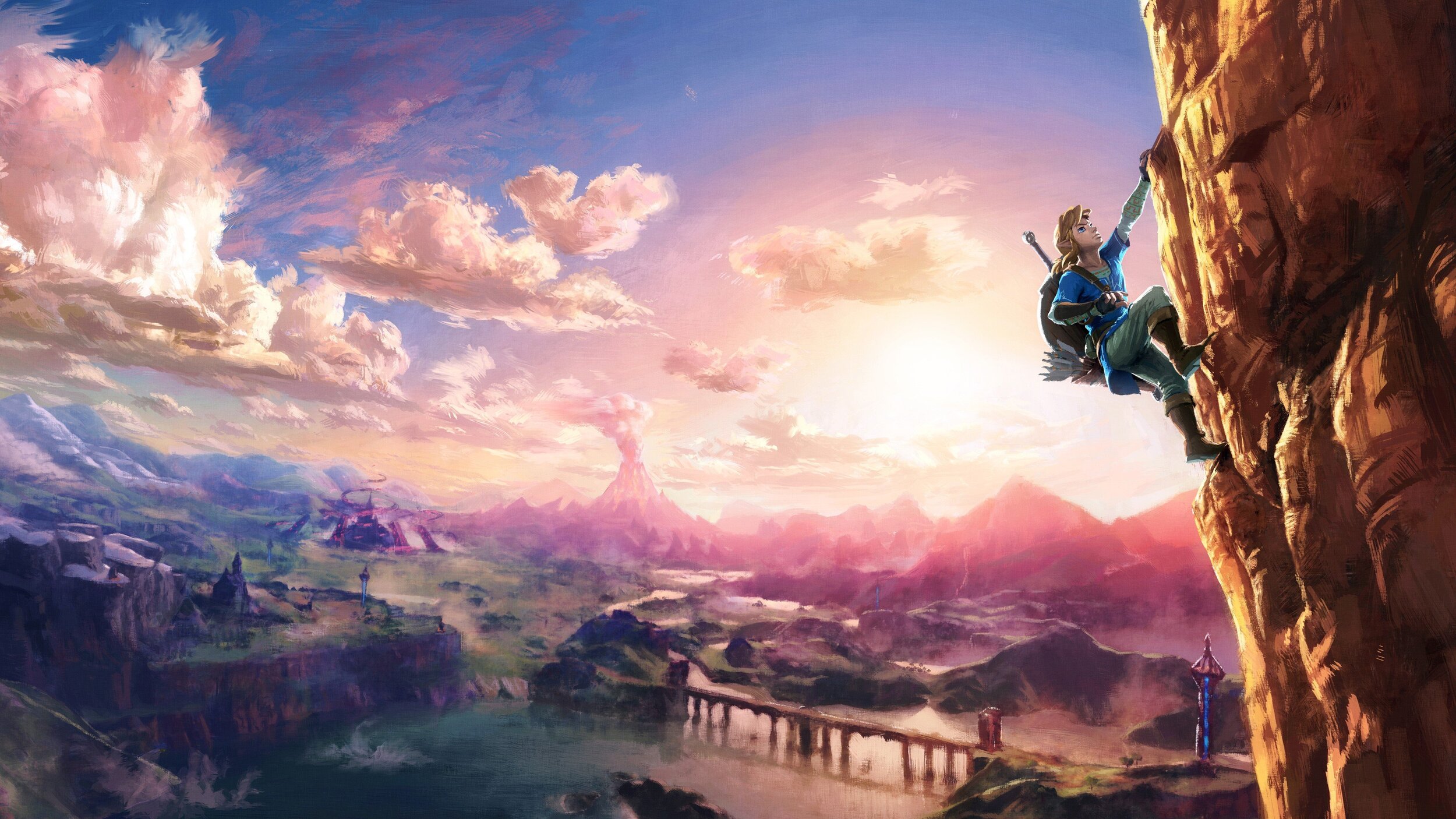Assessing World and Narrative Size in The Legend of Zelda: Link's Awakening
The Legend of Zelda: Link’s Awakening shows both sides of the coin when it comes to scope. The game excels in its condensed, small world, yet simultaneously struggles to make meaning of a small, personal journey. Image: Nintendo
Gaming has historically been segmented by console generations. With each console generation, new hardware has become available, allowing developers to pursue bigger and more ambitious projects. With greater ambition comes greater scale - the wish to make a game huge, engrossing, and welcoming to the player. No genre exemplifies the concepts of ambition and increased scale than the open world game. When Shenmue released on the Dreamcast, not only was it the most expensive game ever developed at the time, but it also pushed what a game could be. Shenmue’s scale was unprecedented and laid the groundwork for many open world games to come. Shenmue showed that huge games can offer large narratives, large worlds, and many gameplay possibilities that can engage players in a way that few other games can.
Since Shenmue’s release and more powerful hardware has come to market, more and more games have pushed for grander scales, attempting to immerse players through creating larger worlds, larger narratives, larger experiences. In the eyes of many developers and publishers in the modern gaming landscape, a bigger scale means a better experience - and to some extent, this is true. The Legend of Zelda: Breath of the Wild is widely agreed to be a master-class in large-scale game design while the large and vividly detailed world of Cyberpunk 2077 stands as one of the most highly anticipated titles of recent memory.
While large worlds and narratives certainly satisfy ambition for developers and provide experiences to get lost in for players, there is also something magical to be said for games that choose a different path. The explosion of indie games in the 2010s proved that there is still a large market for games that are smaller and provide a sharper focus for their mechanics, narratives, and worlds. While large, open world games have a mainstream appeal, they can also manage to be overwhelming to players and may even appear as too big and stand as unfocused as a result. Games that are set in smaller worlds can make for more detailed, well-realized worlds that have a tighter, more optimized design. Smaller stories can make for more personal tales where players can connect with characters on a more intimate level. While larger scales make for longer and theoretically more engaging games, it’s important to remember that smaller-scale games bring something to the table that larger games simply can’t.
Late 2019 saw the release of a remake of The Legend of Zelda: Link’s Awakening, a game that holds a special place in many series fans’ hearts. Perhaps due to its stylized art direction or its unique setting, Link’s Awakening is an experience that, despite having released over a quarter of a century ago, still easily engages players through a tightly designed and well-realized world. At the same time, Link’s Awakening tells a tale of Link having to escape an otherworldly island - a tale which unfortunately fails to make a significant emotional impact on the player. While Link’s Awakening excels gameplay-wise through having a small, tightly crafted world to explore, it also stumbles with its smaller, more personal narrative.
Link’s Awakening exemplifies many good aspects of a smaller scale experience, despite failing to take full advantage of its well-setup narrative. Let’s discuss what those aspects are and further assess the value of games that boldly decide to remain on a small scale.
No doubt deriving from the title’s roots as both a Game Boy title and side project for its original developers, Link’s Awakening excels at delivering a concise, fun-filled experience through offering a world that only offers what it needs to to sell the world and creativity of the game’s setting. Image captured on Nintendo Switch (Undocked).
While this assessment is based off of my time with the 2019 remake, Link’s Awakening wasn’t significantly altered in its HD makeover in regards to its design and storytelling. In fact, almost all of the game’s text boxes and map design are faithfully recreated in the remake with changes primarily being made in the game’s UI, item management, and presentation.
With that said, Link’s Awakening does a phenomenal job at heightening the player’s lust for adventure and exploration through initial limitation. Waking up in Mabe Village with nothing but a shield, the player’s initial available avenues of exploration are few in number. Being unable to lift rocks, jump to cross gaps, or even cut down bushes prevents the player from being able to do much aside from immediately going where they acquire their sword and the game’s first dungeon. Since Mabe Village and its surrounding area are all quite small, the player is surely going to notice everything they can’t interact with. When trying to lift a boulder (or even walking near it if you’re playing the 1993 original), you’ll be informed that Link isn’t strong enough to lift it, teasing the player that they’ll eventually be able to lift and easily access what lies beyond.
When navigating through the Mysterious Forest to the north of the village, the player is going to inevitably come across gaps that they currently have no way to get across. These obstacles become immediately apparent to the player since the small scale of the world makes coming across such obstacles an inevitability. As such, observing these obstacles stick in the player’s mind - since the map is rather small and easy to distinguish (along with the 2019 remake’s inclusion of setting waypoints on the map to return to at a later time). Bombable walls, gaps that can jumped over, boulders that can be lifted and thrown - all of these obstacles prevent full exploration or acquiring in-game upgrades such as pieces of heart that can increase the user’s health capacity. This initial limitation, along with incorporating a small map design, makes it easy for the player to mentally note places that they’ll want to return to when they become more readily equipped to navigate the environment more optimally.
And soon enough, they’ll be able to do just that upon completing Tail Cave, the game’s first dungeon. Link’s Awakening’s dungeons strike a balance of the original Legend of Zelda’s room-based challenges with Link to the Past’s greater focus on puzzle-solving, making for dungeons that offer bite-sized obstacles to be overcome in a couple rooms. The dungeons throughout the title are short in comparison to other entries in the series, but through that short length, the dungeons in the game seldom overstay their welcome. This causes Link’s Awakening to actually have a better flow than most other titles in the series, as many other Zelda titles, namely the 3D entries, often have long dungeons that compromise the game’s overall pacing.
Upon completion, the player is ultimately awarded with their ability to utilize their newly acquired item, Roc’s Feather, to engage with the environment in a capacity that allows them to partially satiate their hunger to explore more of what the world has to offer. Roc’s Feather allows the user to jump across the various gaps that the user has come across thus far, which naturally raises the user’s natural curiosity to use their newly acquired jumping ability to cross such gaps and explore more of the world. Link’s Awakening continues to slowly give the player more and more tools to more optimally navigate its world until they can fully explore it to their heart’s content.
When slowly gaining access to more tools that allow more and more of the world to be uncovered, it makes for a satisfying means of making the player feel gradually stronger throughout the game. As an example, Martha’s Bay is an area where the player is introduced to a vast space with water that has a piece of heart and staircases going into water that connect otherwise separated areas of the overworld. Upon acquiring the Flippers, the player is now able to explore this aquatic area, finally being able to acquire the underwater piece of heart that they will most likely have already noticed upon walking through the area. Additionally, they gain access to an additional dungeon and can more easily navigate an area of the overworld that was previously segmented to them.
While other games implement such a satisfying means of progression, Link’s Awakening’s small world size ensures that the player becomes aware of every kind of obstacle that each item can help them overcome.
The size of Link’s Awakening’s map can be entirely navigated in a matter of minutes - arguably one of the smallest worlds in the series. This conciseness in the game’s world makes way for map design that entirely feels taken advantage of - a rarity in games with larger worlds on display. Image captured on Nintendo Switch (Undocked).
As the player gains access to more and more of the world, another aspect of the game’s small-scale world is how tightly the world itself is designed. Unlike Ocarina of Time’s Hyrule Field that has vast open space with little to do beyond getting from point A to point B, Link’s Awakening’s overworld has various areas that each contain unique and clearly indicated challenges to be overcome. Yarna Desert is just a small corner of the game’s overworld and yet it offers pieces of heart to collect, a miniboss to fight that that gives access to further story progression - making it feel like a dense area that offers a lot of gameplay in a short period of time.
Tal Tal Heights is another area that, while seemingly small, is designed in such a way that consistently rewards the player’s sense of curiosity and discovery through rewards that ultimately strengthen the player. After completing Angler’s Tunnel, a dungeon found in this area, the player’s newly acquired Flippers can immediately be used when swimming in the surrounding area, where there are caves that can be swum into, all of which reward the player through either a piece of heart or song that can allow fast travel between different areas of the island. Each area brings with it unique challenges that all manage to test the player to use different items, sometimes in combination with one another, in order to progress and get stronger. This reinforces the player’s desire to explore what they previously were not able to.
Indeed, each area on Koholint Island cuts the fat and only provides what’s necessary to have the area filled with things to do while still feeling large enough to feel like a believable, immersive world. With smaller, more focused areas comes a quicker means of progression. So long as the player is paying attention to the environment around them and remains curious to apply items in areas that were previously obstacles to them, the player will consistently feel like they’re progressing, both in terms of getting stronger and in terms of uncovering the game’s entire world. This results in an ultimately shorter experience - but contrary to many a marketing slogan, smaller can often mean better.
It’s no secret that various Zelda games and Action-RPGs in general have a reputation of feeling bloated at times. While agreed to be one of the stronger entries in the series, Twilight Princess notoriously has a slow opening and long sections of down time between dungeons and accessing new areas of the map. While it does have a significantly longer running time than that of Link’s Awakening, Twilight Princess struggles in regards to keeping the player consistently being either challenged or rewarded for overcoming such challenges. While Twilight Princess playthroughs tend to be anywhere from 15-30 hours, most people will finish Link’s Awakening in 10 hours or less on a first playthrough. Though shorter clear times bring them a connotation that such games have less content and value to offer, that connotation is an often unfair and invalid one. Link’s Awakening fully realizes its smaller, more concentrated world without having to resort to excessive backtracking or segments in which the player is prevented from progressing for a long period of time.
As such, I look back fondly at my time with Link’s Awakening, as there was no single section that I felt hurt the overall flow of the game - something that’s a far more uncommon sentiment to have with larger-scale titles. There’s a reason why Grezzo didn’t feel the need to throw in completely new areas or increase the scale of the game - the world of Link’s Awakening is masterfully crafted one to the point that it really doesn’t need much modification.
Link’s Awakening’s narrative, while certainly distinct from other Zelda titles, ultimately suffers from creating any kind of stakes. Despite attempts at developing a relationship with Marin and the island itself, Link’s Awakening stumbles with giving the player a true reason to feel emotionally connected to the game’s world, resulting in a climax that feels emotionally hollow. Image: Nintendo via YouTube.
So far, this discussion has been praising Link’s Awakening for its implementation of small-scale design due to its sharper focus, tighter world design, and snappy pace. However, there’s another aspect to small-scale game design - that of narrative design. Adventure titles often tell grand epics that involve travelling across a continent or even globe, often dealing with grand journeys dealing with the fate of the world. Large scale stories bring with them large stakes so as to build a story with a great amount of tension. Smaller-scale stories are capable of reaching the same amount of tension as large-scale stories, just through different means. Often, smaller-scale stories put a greater focus on either man-versus-man or man-versus-self narratives, with overall smaller stakes. The tension from these kinds of stories more often than not come from character interactions and relationships along with internal battles that protagonists face.
The narrative offered within Link’s Awakening is one that is certainly more personal and of a significantly smaller scale with other titles in the series. Put between the grander, save-the-world narratives of Link to the Past and Ocarina of Time, Link’s Awakening’s tale is one that’s refreshingly simple - get home. Washing up on a remote island after a storm, Link must awaken the Wind Fish in order to successfully leave the island. This setup does a great job at preparing the player for a smaller, more character-driven journey. Such is immediately apparent with the game’s pre-Title Screen scenario, with Marin finding Link on the beach and taking him to her house.
While the journey starts strong with short but effective character interactions, the narrative ultimately fails to deliver any kind of meaningful emotional impact on the player when I would arguably that it was easily poised to do so. What makes Link’s Awakening flounder in regards to taking full advantage of its smaller, more personal narrative setup?
The following section contains story spoilers for Link’s Awakening.
Upon setting off and acquiring Link’s sword and heading towards the game’s initial dungeon, character interactions immediately take a plunge. The player can talk to NPCs in Mabe Village and a few other sections of the island. While they offer quirky dialogue, very rarely do they offer anything that establishes a deep connection between the player and the game’s world and characters. The closest the game gets to establishing this connection is the relationship between Link and Marin. The famous scene of Link and Marin sitting together on the beach looking out to the ocean is perhaps the title’s strongest moment from a narrative perspective. We get a quiet scene between the two characters with distinct imagery, offering dialogue that, if only for a brief moment, captures the feelings of isolation and loneliness that Marin and the inhabitants of the island possess. Marin prepares to confess feelings for Link before she ultimately decides to keep them to herself - a story beat that repeats itself a few more times throughout the narrative to a shallow, almost non-existent effect.
As the player continues progressing through the game’s dungeons and explores optional caverns, it becomes increasingly apparent that Koholint Island itself is a dream constructed by the Wind Fish, and by waking it up, the island and all that live upon it will cease to be. Like with the basic scenario of leaving an island to get home, this idea is one that’s novel and can bring about emotional and philosophical questions. However, any story’s responsibility is to turn ideas into fleshed out narrative events and questions that entertain, challenge, and engage the reader/viewer/player, and unfortunately, Link’s Awakening simply doesn’t take responsibility for the ideas that it presents.
The end of the game’s story sees the Wind Fish waking up and flying in the sky, with various shots of Koholint’s inhabitants fading away, with the only remnant of the island remaining is Link lying alone in the ocean. Despite seeing the characters we’ve interacted with throughout our adventure including Marin, the character that we’ve interacted with the most, this moment fails to leave any kind of emotional punch. Seeing characters that you connect with suddenly vanish into nothingness is a story beat that has the potential to have a reader/viewer/player reflect on the kinds of interactions they’ve had with these characters. Seeing characters live among one another, all possessing human characteristics that you connect with, is enough to make the player question the morality of their actions and whether or not the selfish desire of freedom is worth the erasure of innocent bystanders. At least, that’s the effect a moment like this could have if players had more of an opportunity to connect with these characters on a closer, more intimate level.
Seeing Link float in the ocean on his lonesome where Koholint used to be is a moment that feels remarkably empty. Through failing to take opportunities to have characters meaningfully interact with the player, at least to the point where the player can be exposed to the humanity of the game’s NPCs, the game merely has the potential of a meaningful story and nothing more. The pieces are there, but they aren’t put together in the right places. While the story offers a promising setup, the lack of meaningful character interactions make the somber conclusion of the game lack any dramatic depth.
This concludes the section containing story spoilers for Link’s Awakening.
Despite failing to live up to its narrative’s potential, Link’s Awakening successfully incorporates the basic elements of a smaller-scale story. Smaller conflicts, whether internal conflicts or external conflicts that only involve a couple people, can often lead to potent character drama. While Link’s Awakening fails to give weight to its smaller conflict, its basic foundation shows that this title understands what makes a smaller-scale narrative work. As a positive example of smaller-scale storytelling done well, 2018’s Celeste does a phenomenal job of giving weight to character actions and gameplay through short yet incredibly effective character interactions and relationships. While the stakes and conflict only involved a handful of characters, that game’s story managed to resonate with thousands of players.
Games with smaller-scale narratives such as Celeste have proven that these kinds of narratives do work and have a place among larger save-the-world plots the proliferate the gaming market. It is of my opinion that Link’s Awakening understands the potential and uniqueness of its narrative in comparison to other titles in its series, but it simply doesn’t grasp how it can take full advantage of it. While this is somewhat understandable for a 1993 Game Boy title in a gaming landscape where meaningful narrative experiences were uncommon on handheld devices, it’s a shame that the 2019 remake neglected to improve the title’s approach to its narrative in any way.
Larger-scale world and narrative design is only becoming more common. Despite that, games like Link’s Awakening remind us that there’s indeed value in creating and engaging with smaller experiences. Image: Nintendo
AAA game developers will certainly continue pursuing larger, grander experiences for years to come, consistently pushing the envelope for how much content a game can provide. With that said, though, remakes and remasters of older titles along with new releases that come mostly from independent developers and sometimes from larger studios remind us that that there’s a reason why so many smaller-scale games are beloved. A smaller scale, a smaller world, and a smaller narrative all provide opportunities for gameplay and storytelling that aren’t nearly as feasible in significantly larger titles.
This isn’t intended as a disdain towards large, open games - rather, this is an acknowledgement of what smaller, often less mainstream games bring to the table. Link’s Awakening provides an experience that’s small and short-lived, yet nevertheless impactful thanks to its focused, meaningfully constructed world and puzzles and a personal tale that has the basic foundation to resonate with players on an incredibly intimate level if more dedication was given to its writing.
The fact that Nintendo followed up Breath of the Wild with the remake of Link’s Awakening only highlights the differences between both titles different methods of delivering the same design philosophies. Both games depend on player curiosity and exploration - while Breath of the Wild encourages exploration through providing large vistas serving as hubs to find hidden Korok Seeds and Shrines to complete, Link’s Awakening accomplishes a similar feat through cleverly forming obstacles near the player to naturally encourage them to explore as more and more tools become available to them. Both of these methods ultimately aim to give freedom to the player and satisfy their curiosity - they just go about doing so in different ways.
Objectively speaking, neither method is better than the other, but in an era where large titles are being put on a higher pedestal than smaller, more focused experiences, it’s important to highlight, share, and appreciate the experiences that small worlds and narratives provide. Link’s Awakening is but one example of how smaller-scale design can nevertheless make a world feel as believable and immersive as it is tightly constructed and uninterested in wasting the player’s time. Through its tight design and consideration for making an experience that provides a consistent feeling of progression and gradually expanding sense of freedom and exploration, Link’s Awakening provides an adventure that I recall very fondly - an assessment that is in large thanks to the title’s size.
Thank you so much for reading! What are your thoughts on small-scale game design versus large-scale game design? What are some examples of strong small-scale game and narrative design? Do you think Link’s Awakening is a strong example of small-scale world and narrative design? As always, join the conversation and let me know what you think!










